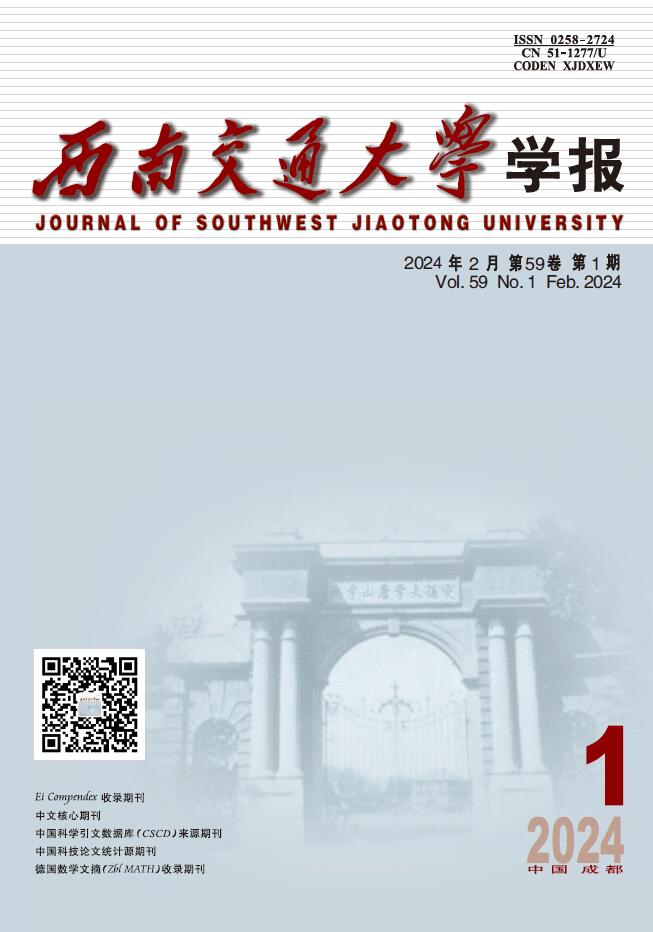 Volume 59
Issue 1
Volume 59
Issue 1
| Citation: | WEI Lai, ZENG Jing, GAO Hao, QU Sheng, SUN Yi. Wheel Out-of-Roundness Identification Approach Based on Axlebox High-Frequency Vibrations[J]. Journal of Southwest Jiaotong University, 2024, 59(1): 211-219. doi: 10.3969/j.issn.0258-2724.20211085 |
In order to realise the real-time detection of wheel out-of-roundness (OOR) for high-speed trains, the spectral characteristics and mapping relationship between the axlebox high-frequency vibration and the wheel OOR are studied. The amplitude and order of the wheel OOR are identified using the frequency-domain integration method. Firstly, manifestations of the wheel polygonisation, rail corrugation and track modes of China high-speed railways are investigated through static measurements and laboratory experiments. Secondly, the time-frequency characteristics and evolution principle of the bogie axlebox vibrations are obtained through the long-term operation performance tracking test of a high-speed train. Finally, taking the 20th order wheel polygonisation as the research object, an identification approach of the wheel OOR order and amplitude is proposed based on the frequency-domain integration method. The results show that the third-order bending modal frequency of the China railway track system Ⅱ (CRTS-Ⅱ) track slab is 592 Hz. When the train is running at a speed of 300 km/h, the response frequencies due to the 20th-order wheel polygonisation and the rail corrugation with a wavelength of 136 mm are 580 and 613 Hz, respectively. The dominant frequencies of rail mode, wheel polygonisation and rail corrugation are relatively concentrated. The amplitude of high-frequency vibration of axlebox increases with the increase of vehicle speed and mileage after re-profiling. Theoretically, the amplitude and order of the wheel OOR can be identified by the integration of accelerations in the frequency domain. The relative error between the identified 20th-order wheel OOR results based on the field-tested axlebox acceleration and the static measured values is less than 5%.
| [1] |
TAO G Q, WEN Z F, JIN X S, et al. Polygonisation of railway wheels: a critical review[J]. Railway Engineering Science, 2020, 28(4): 317-345. doi: 10.1007/s40534-020-00222-x
|
| [2] |
金学松,吴越,梁树林,等. 高速列车车轮多边形磨耗、机理、影响和对策分析[J]. 机械工程学报,2020,56(16): 118-136. doi: 10.3901/JME.2020.16.118
JIN Xuesong, WU Yue, LIANG Shulin, et al. Characteristics, mechanism, influences and countermeasures of polygonal wear of high-speed train wheels[J]. Journal of Mechanical Engineering, 2020, 56(16): 118-136. doi: 10.3901/JME.2020.16.118
|
| [3] |
DAI H Y, LI D, WANG J, et al. Study on the mechanism of high order out of round roughness of high speed railway train’s wheel[C]//Proceedings of the 11th International Conference on Contact Mechanics and Wear of Rail/Wheel System. Delft: CRC, 2018: 189-195.
|
| [4] |
WU X W, RAKHEJA S, CAI W B, et al. A study of formation of high order wheel polygonalization[J]. Wear, 2019, 424/425: 1-14. doi: 10.1016/j.wear.2019.01.099
|
| [5] |
姜子清,司道林,李伟,等. 高速铁路钢轨波磨研究[J]. 中国铁道科学,2014,35(4): 9-14. doi: 10.3969/j.issn.1001-4632.2014.04.02
JIANG Ziqing, SI Daolin, LI Wei, et al. On rail corrugation of high speed railway[J]. China Railway Science, 2014, 35(4): 9-14. doi: 10.3969/j.issn.1001-4632.2014.04.02
|
| [6] |
谷永磊,赵国堂,王衡禹,等. 轨道振动特性对高速铁路钢轨波磨的影响[J]. 中国铁道科学,2016,37(4): 42-47. doi: 10.3969/j.issn.1001-4632.2016.04.07
GU Yonglei, ZHAO Guotang, WANG Hengyu, et al. Effect of track vibration characteristics on rail corrugation of high speed railway[J]. China Railway Science, 2016, 37(4): 42-47. doi: 10.3969/j.issn.1001-4632.2016.04.07
|
| [7] |
GRASSIE S L. Rail corrugation: characteristics, causes, and treatments[J]. Proceedings of the Institution of Mechanical Engineers, Part F Journal of Rail and Rapid Transit, 2009, 223(6): 581-596. doi: 10.1243/09544097JRRT264
|
| [8] |
LIU X Y, ZHAI W M. Analysis of vertical dynamic wheel/rail interaction caused by polygonal wheels on high-speed trains[J]. Wear, 2014, 314(1/2): 282-290.
|
| [9] |
CHEN M, SUN Y, GUO Y, et al. Study on effect of wheel polygonal wear on high-speed vehicle-track-subgrade vertical interactions[J]. Wear, 2019, 432/433: 102914.1-102914.9. doi: 10.1016/j.wear.2019.05.029
|
| [10] |
WU X W, CHI M R, WU P B. Influence of polygonal wear of railway wheels on the wheel set axle stress[J]. Vehicle System Dynamics, 2015, 53(11): 1535-1554. doi: 10.1080/00423114.2015.1063674
|
| [11] |
QU S, ZHU B, ZENG J, et al. Experimental investigation for wheel polygonisation of high-speed trains[J]. Vehicle System Dynamics, 2021, 59(10): 1573-1586. doi: 10.1080/00423114.2020.1772984
|
| [12] |
ZHANG J, HAN G X, XIAO X B, et al. Influence of wheel polygonal wear on interior noise of high-speed trains[J]. Journal of Zhejiang University–Science A (Applied Physics & Engineering), 2014: 1002-1018.
|
| [13] |
王远,佟岩. 高速动车组车轮多边形对车内噪声的影响[J]. 噪声与振动控制,2018,38(1): 147-150. doi: 10.3969/j.issn.1006-1355.2018.01.029
WANG Yuan, TONG Yan. Influence of polygonal wheels on interior noise of high-speed trains[J]. Noise and Vibration Control, 2018, 38(1): 147-150. doi: 10.3969/j.issn.1006-1355.2018.01.029
|
| [14] |
徐磊,陈宪麦,徐伟昌,等. 基于小波和Wigner-Ville分布的轨道不平顺特征识别[J]. 中南大学学报(自然科学版),2013,44(8): 3344-3350.
XU Lei, CHEN Xianmai, XU Weichang, et al. Explored of track irregularity’s characteristic identification based on wavelet method and Wigner-Ville distribution[J]. Journal of Central South University (Science and Technology), 2013, 44(8): 3344-3350.
|
| [15] |
XIAO X, SUN Z, SHEN W A. A Kalman filter algorithm for identifying track irregularities of railway bridges using vehicle dynamic responses[J]. Mechanical Systems and Signal Processing, 2020, 138: 106582.1-106582.27. doi: 10.1016/j.ymssp.2019.106582
|
| [16] |
WESTEON P F, LING C S, ROBERTS C, et al. Monitoring vertical track irregularity from in-service railway vehicles[J]. Proceedings of the Institution of Mechanical Engineers Part F Journal of Rail and Rapid Transit, 2007, 221(1): 75-88. doi: 10.1243/0954409JRRT65
|
| [17] |
MOLODOVA M, LI Z L, DOLLEVOET R. Axle box acceleration: measurement and simulation for detection of short track defects[J]. Wear, 2011, 271(1/2): 349-356.
|